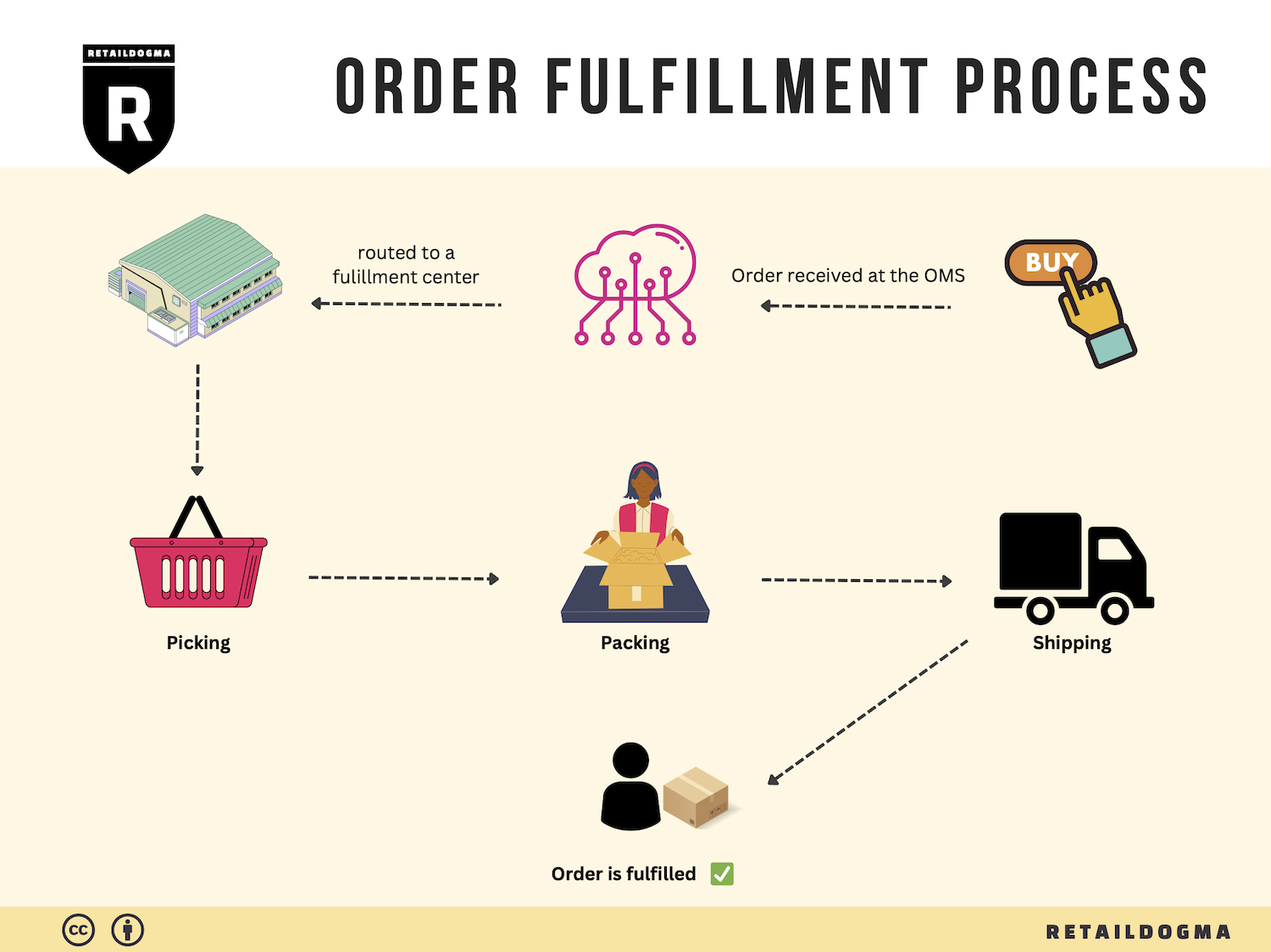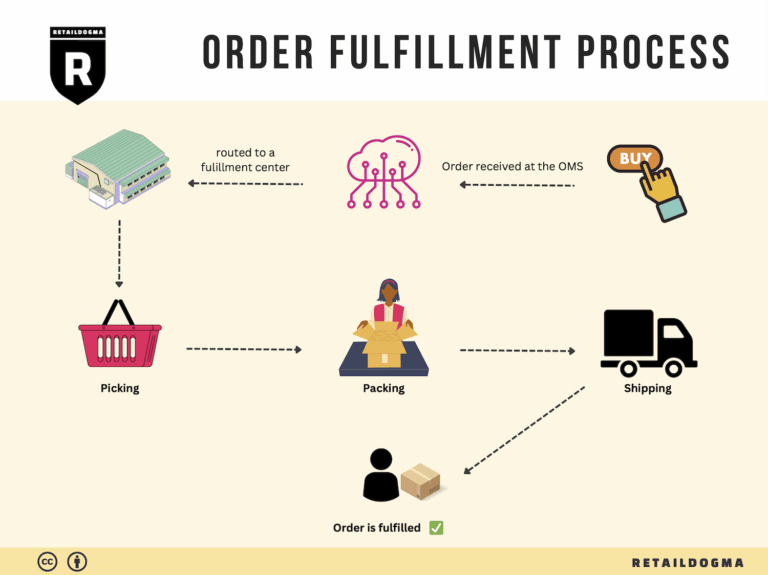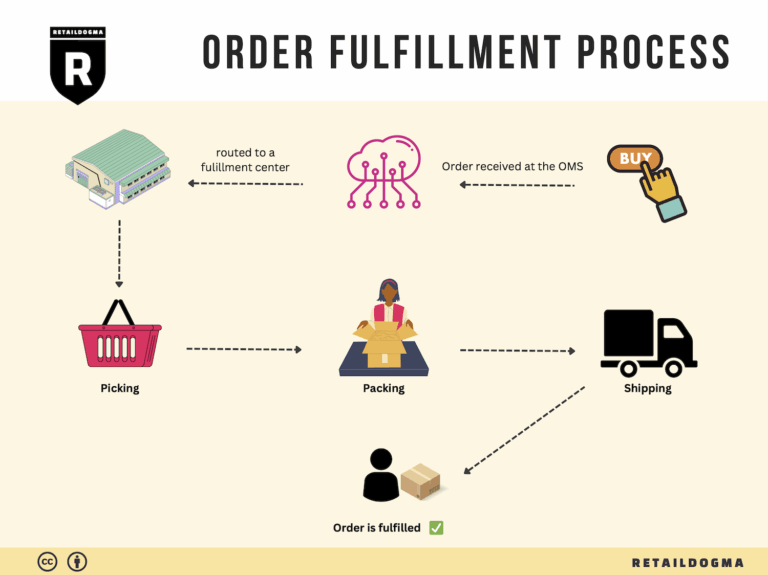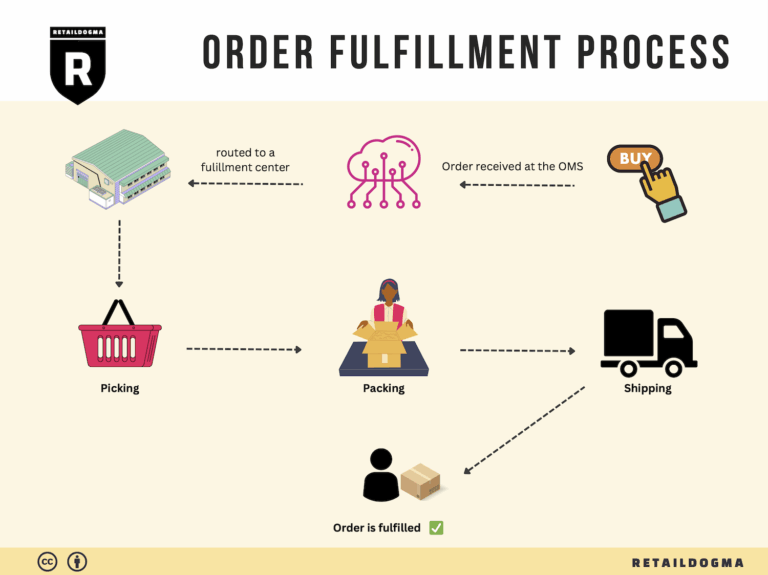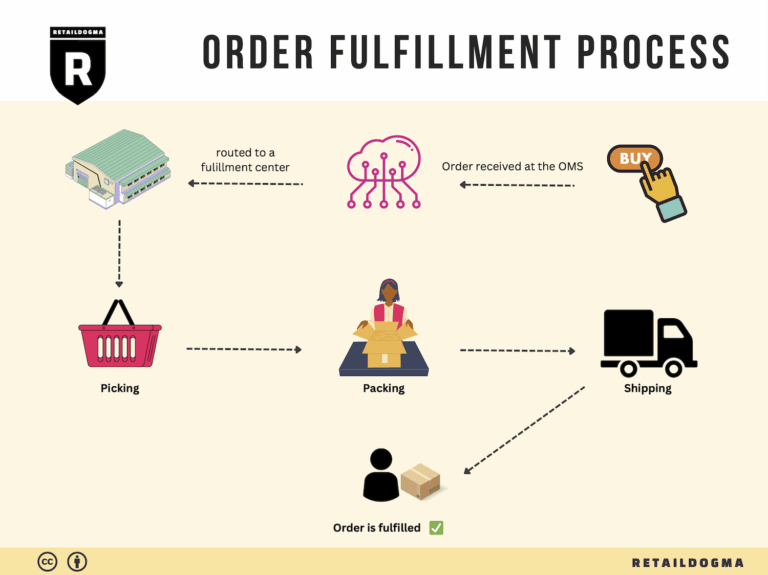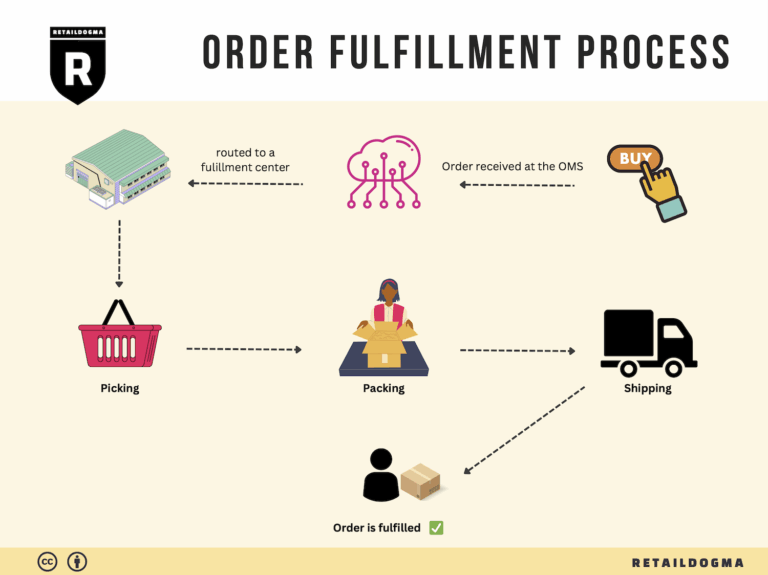What Is A Fulfillment Center? A Complete Guide (2025)
What is E-commerce Fulfillment? An Introduction for Growing Businesses
Understanding the Challenges of E-commerce Fulfillment
As an e-commerce business owner, you may find yourself overwhelmed with the logistics of packing and shipping orders. Managing inventory, ensuring timely deliveries, and maintaining customer satisfaction can quickly become a daunting task. The fulfillment process—the journey of getting a product from your warehouse to your customer’s doorstep—often becomes the bottleneck in scaling your operations. This is where an effective e-commerce fulfillment strategy can make a significant difference.
What is E-commerce Fulfillment?
At its core, e-commerce fulfillment refers to the comprehensive process of receiving, processing, and delivering orders to customers. It encompasses everything from warehousing and inventory management to packing, shipping, and handling returns. As businesses grow, the complexities of fulfillment can increase, leading many to seek external partners to streamline their operations.
What This Guide Will Cover
In this guide, we will delve into various fulfillment models that can help your business scale effectively. One popular option is Fulfillment by Amazon (FBA), which allows sellers to leverage Amazon’s vast logistics network to reach customers quickly. We will also explore Third-Party Logistics (3PL) providers, who can offer tailored solutions that fit your specific needs.
Beyond models, we will outline the core services involved in e-commerce fulfillment, including inventory management, order processing, and shipping options. Understanding these services will help you determine which aspects of fulfillment are critical for your business.
Choosing the right fulfillment partner is crucial. We’ll provide insights on what to look for when evaluating potential partners, including their technology capabilities, service levels, and geographic reach. Additionally, we will discuss pricing structures to help you understand the financial implications of various fulfillment options.
Empowering Smart Decisions
The goal of this guide is to empower you with the knowledge to make informed decisions about your logistics strategy. By understanding the nuances of e-commerce fulfillment, you can optimize your operations, enhance customer satisfaction, and ultimately drive growth for your business. Whether you are just starting out or looking to scale, the insights shared here will serve as a valuable resource in navigating the complexities of fulfillment in the e-commerce landscape.
What You’ll Learn In This Guide
- What is E-commerce Fulfillment? An Introduction for Growing Businesses
- The Order Fulfillment Process: From ‘Buy’ Button to Customer’s Door
- Comparing Fulfillment Models: In-House vs. 3PL vs. Dropshipping
- A Deep Dive into Amazon FBA: Pros, Cons, and Who It’s For
- Core Services Offered by Fulfillment Centers
- How to Choose a Fulfillment Partner: A 6-Point Checklist
- Understanding Fulfillment Pricing: A Breakdown of Common Fees
- Frequently Asked Questions (FAQs) about Fulfillment
- Conclusion: Is Outsourcing Fulfillment the Right Move for Your Business?
- Important Disclaimer
The Order Fulfillment Process: From ‘Buy’ Button to Customer’s Door
1. Receiving Inventory
The first step in the order fulfillment process is receiving inventory. This involves the delivery of products to the fulfillment center, where they are checked for quantity and quality against the purchase orders. Each item is assigned a unique identifier, commonly known as a Stock Keeping Unit (SKU). This process ensures that all products are accounted for and meet quality standards before they are stored in the warehouse.
Importance: Efficient receiving is crucial as it sets the foundation for the entire fulfillment operation. If there are discrepancies in inventory counts or quality issues, it can lead to stockouts or returns, affecting customer satisfaction.
Key Term: SKU (Stock Keeping Unit) – A unique identifier for each product that facilitates inventory tracking.
2. Warehouse Storage
Once the inventory is received and verified, the next step is warehouse storage. Products are categorized and placed in designated storage locations within the fulfillment center. This organization can be based on various factors such as product size, weight, or sales velocity. Effective warehouse management systems (WMS) play a significant role in optimizing storage space and maintaining accurate inventory records.
Importance: Proper storage ensures that items are easily accessible for order picking. An organized warehouse minimizes the time spent locating products, which is critical for meeting customer delivery expectations.
Key Term: Warehouse Management System (WMS) – Software that manages inventory levels, order fulfillment, and warehouse operations.

3. Order Picking
Order picking is the process of retrieving products from their storage locations to fulfill customer orders. Once an order is placed, a pick list is generated, detailing the items needed for that order. Workers, often equipped with handheld devices, navigate the warehouse to collect the specified items efficiently.
Importance: The speed and accuracy of order picking directly impact fulfillment times and customer satisfaction. Inefficient picking processes can lead to delays and errors, resulting in incorrect orders.
Key Term: Pick List – A document or digital list that outlines the items and quantities to be retrieved for fulfilling a specific order.
4. Order Packing
After items are picked, they move to the packing stage. Here, the products are carefully packed into boxes or containers suitable for shipping. This step often includes adding packing slips, promotional materials, or other items that enhance the customer experience. Companies may also use packing algorithms to determine the best way to pack items to minimize shipping costs while ensuring safety during transit.
Importance: Effective packing is vital for protecting products during shipping and enhancing the unboxing experience for customers. Poor packing can lead to damage during transit, which increases return rates and customer dissatisfaction.
Key Term: Packing Slip – A document included in the package that lists the items included in the order, serving as a receipt for the customer.

5. Shipping & Delivery
The final step in the order fulfillment process is shipping and delivery. Once orders are packed, they are labeled and handed over to shipping carriers. The choice of carrier and shipping method can affect delivery times and costs. Many e-commerce businesses leverage multiple carriers to optimize shipping efficiency and pricing, using services like Amazon FBA to handle logistics.
Importance: Timely shipping and delivery are critical in maintaining customer satisfaction and loyalty. The ability to provide real-time tracking information also enhances the customer experience, as it keeps buyers informed about their order status.
Key Term: Last Mile Delivery – The final step of the delivery process where the product is transported from the fulfillment center to the customer’s door, often considered the most critical phase in logistics.
In summary, the order fulfillment process is a complex but essential operation for e-commerce businesses. Each step, from receiving inventory to shipping and delivery, plays a crucial role in ensuring customer satisfaction and operational efficiency. By understanding and optimizing these steps, businesses can enhance their fulfillment capabilities, ultimately leading to increased sales and customer loyalty.
Comparing Fulfillment Models: In-House vs. 3PL vs. Dropshipping
Comparison of Fulfillment Models
| Model | Who Handles Inventory | Best For (Business Stage) | Key Advantage | Key Disadvantage |
|---|---|---|---|---|
| In-House Fulfillment | Business Owner/Team | Startups to Small Businesses | Full control over inventory and operations | High upfront costs and operational complexity |
| Third-Party Logistics (3PL) | 3PL Provider | Growing to Medium-Sized Businesses | Scalability and expertise in logistics | Less control over inventory and fulfillment process |
| Dropshipping | Supplier | Startups and Entrepreneurs | Low upfront investment and risk | Lower profit margins and reliance on suppliers |
In-House Fulfillment
In-house fulfillment involves managing the entire inventory and logistics process within your own facilities. This model is particularly suitable for startups and small businesses that want complete control over their operations. By handling inventory directly, businesses can ensure quality control, customize packaging, and maintain direct relationships with their customers. However, in-house fulfillment comes with significant challenges. It requires substantial upfront investment in warehouse space, technology, and labor. Additionally, as order volume grows, businesses may find it increasingly difficult to manage logistics efficiently without the right systems in place. The complexity of operations can hinder scalability, making it a less viable option for businesses looking to expand rapidly.
Third-Party Logistics (3PL)
Third-party logistics (3PL) involves partnering with an external service provider to handle inventory management, warehousing, and shipping. This model is ideal for growing to medium-sized businesses that seek to scale operations without the burden of managing logistics internally. One of the primary advantages of 3PL is the scalability it offers. Businesses can easily adjust their logistics needs as demand fluctuates, without the need for significant investment in infrastructure. Furthermore, 3PL providers often have specialized expertise in logistics, enabling businesses to benefit from optimized shipping rates and efficient order fulfillment processes. However, the downside is that businesses relinquish some control over their inventory and fulfillment processes. This can lead to challenges in maintaining brand consistency and customer service if the 3PL provider does not meet expectations.
Dropshipping
Dropshipping is a fulfillment model where the retailer does not hold inventory but instead transfers customer orders directly to suppliers, who then ship the products to the customer. This model is particularly appealing to startups and entrepreneurs who want to minimize upfront investment and operational risk. With dropshipping, businesses can offer a wide range of products without the financial burden of maintaining inventory. This allows for greater flexibility in testing new products and market trends. However, dropshipping also comes with its own set of challenges. Profit margins tend to be lower compared to other models, as suppliers take a cut of the sales. Additionally, businesses are heavily reliant on suppliers for inventory quality and shipping times. Any delays or issues on the supplier’s end can directly impact customer satisfaction, making it essential to choose reliable partners.
Conclusion
When selecting a fulfillment model, businesses must consider their current stage of growth, financial resources, and long-term goals. Each model presents unique advantages and disadvantages that can significantly impact operational efficiency and customer satisfaction. By understanding the nuances of in-house fulfillment, third-party logistics, and dropshipping, e-commerce businesses can make informed decisions that align with their strategic objectives. Whether opting for complete control with in-house fulfillment, leveraging expertise with 3PL, or minimizing risk through dropshipping, choosing the right fulfillment strategy is critical for scaling e-commerce operations effectively.
A Deep Dive into Amazon FBA: Pros, Cons, and Who It’s For
Understanding Fulfillment by Amazon (FBA)
Fulfillment by Amazon (FBA) is a service that allows e-commerce sellers to store their products in Amazon’s fulfillment centers. In this model, Amazon takes on the responsibility of storage, packaging, shipping, and customer service for these products. Sellers simply send their inventory to Amazon, which then handles the logistics. This service is particularly beneficial for businesses looking to scale quickly and efficiently, as it leverages Amazon’s vast logistics network.
How FBA Works
-
Inventory Preparation: Sellers prepare their products according to Amazon’s guidelines, which include labeling and packaging requirements.
-
Shipping to Amazon: Once prepared, sellers ship their inventory to Amazon’s fulfillment centers. Amazon has over 100 active fulfillment centers across the United States, strategically located to optimize shipping times.
-
Storage: The products are stored in Amazon’s warehouses until they are sold. Amazon uses sophisticated inventory management systems to track stock levels and manage storage.
-
Order Fulfillment: When a customer places an order for a product, Amazon picks, packs, and ships the item on behalf of the seller. This process is typically faster than what many small to mid-sized businesses can achieve on their own.
-
Customer Service: Amazon also handles customer inquiries and returns, providing a level of service that can enhance customer satisfaction.
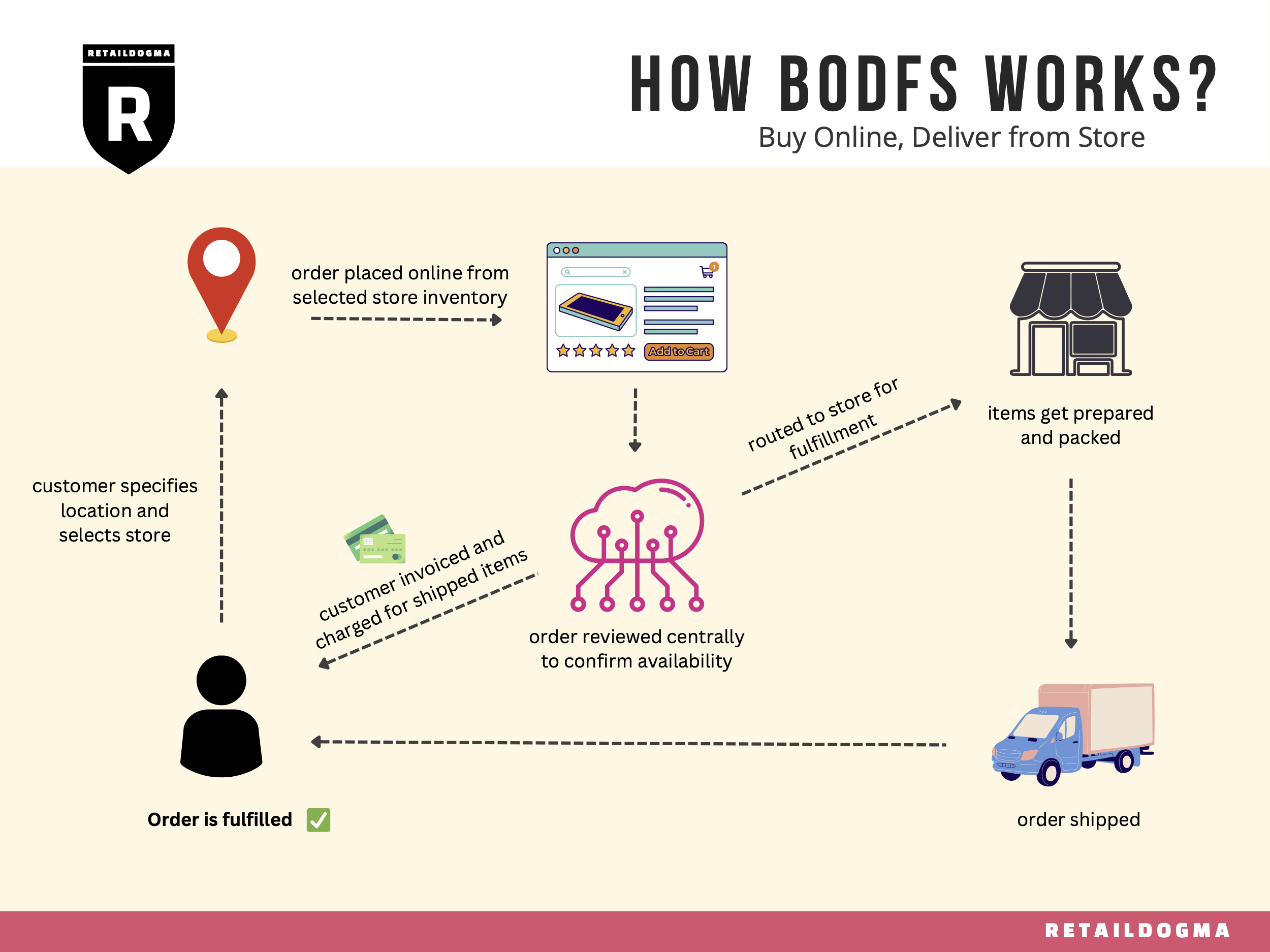
-
Payment: After the order is fulfilled, Amazon processes the payment and transfers the funds to the seller, minus the applicable fees.
Pros of Using FBA
-
Prime Eligibility: Products fulfilled through FBA are automatically eligible for Amazon Prime, which can significantly increase visibility and sales. Prime members tend to prefer Prime-eligible products due to the benefits of fast shipping.
-
Customer Trust: Leveraging Amazon’s brand can instill trust in customers. Many consumers are more likely to purchase from sellers using FBA because they recognize the reliability of Amazon’s fulfillment services.
-
Multi-Channel Fulfillment: FBA allows sellers to fulfill orders from other sales channels (like their own websites or eBay) using Amazon’s logistics network. This can streamline operations and reduce the complexity of managing multiple inventory sources.
-
Scalability: FBA is designed to help businesses scale quickly. As demand for a product increases, sellers can send more inventory to Amazon without needing to invest heavily in their own warehousing and logistics systems.
-
Reduced Operational Burden: By outsourcing fulfillment to Amazon, sellers can focus on other aspects of their business, such as marketing and product development, rather than logistics.
Cons of Using FBA
-
High Fees: FBA comes with various fees, including storage fees, fulfillment fees, and additional charges for long-term storage. For some sellers, these costs can significantly cut into profit margins, especially for low-cost or slow-moving items.
-
Strict Inventory Rules: Amazon has specific requirements for inventory management, including restrictions on how many units can be stored and how long they can remain in the fulfillment center. Non-compliance can result in additional fees or inventory removal.
-
Commingling Risks: When sellers use FBA, their products may be stored alongside those of other sellers. This can lead to issues where customers receive the wrong product or where inventory is mixed, complicating returns and accounting.
-
Loss of Control: By outsourcing fulfillment, sellers may feel a loss of control over their inventory and customer interactions. Issues that arise may take longer to resolve due to the involvement of a third party.
-
Complexity in Returns Management: While Amazon handles returns for FBA sellers, the process can sometimes lead to complications, especially for sellers who need to manage the quality of returned items.
Who is FBA Best For?
FBA is particularly well-suited for:
-
Small to Medium-Sized Businesses: Businesses that are growing quickly and need a scalable fulfillment solution without the overhead of managing their own warehouses.
-
Sellers with High Sales Volume: Sellers who have established a product-market fit and are experiencing consistent sales can benefit from the speed and reliability of FBA.
-
E-commerce Entrepreneurs: New entrepreneurs looking to enter the market with minimal investment in logistics can use FBA as a way to leverage Amazon’s established infrastructure.
-
Brands Looking to Enhance Customer Trust: Businesses that want to gain credibility and visibility in a crowded marketplace can benefit from the trust associated with the Amazon brand.
-
Multi-Channel Sellers: Businesses that sell across multiple platforms and need a unified logistics solution can use FBA to simplify their operations.
In conclusion, while Fulfillment by Amazon offers numerous benefits that can help businesses scale effectively, it is essential to weigh these against the potential drawbacks. Sellers should carefully consider their business model, product type, and growth trajectory when deciding if FBA is the right fit for their operations.
Core Services Offered by Fulfillment Centers
Inventory Management & Warehousing
Fulfillment centers provide comprehensive inventory management and warehousing services, which are essential for e-commerce businesses aiming to scale efficiently. This service encompasses the storage of products in a secure, organized manner within the fulfillment center’s facilities. Advanced inventory management systems are utilized to track stock levels, manage product locations, and oversee inventory turnover.
Benefits:
1. Real-Time Tracking: E-commerce businesses can monitor their inventory levels in real time, reducing the risk of stockouts and overstock situations. This capability enables better forecasting and inventory planning.
2. Space Optimization: Fulfillment centers utilize sophisticated storage solutions to maximize space, allowing businesses to store more products without the need for larger physical locations.
3. Cost Efficiency: By outsourcing warehousing needs, businesses can save on overhead costs associated with maintaining their own facilities, such as rent, utilities, and staffing.
Pick and Pack Services
Pick and pack services are a cornerstone of fulfillment operations. This process involves selecting items from inventory (picking) and preparing them for shipment (packing). Fulfillment centers employ efficient picking methodologies—such as batch picking or zone picking—to streamline this process, ensuring that orders are fulfilled quickly and accurately.
Benefits:
1. Speedy Fulfillment: With dedicated teams and optimized systems, fulfillment centers can significantly reduce order processing times, leading to faster delivery for customers. This speed is crucial for maintaining customer satisfaction and loyalty in a competitive e-commerce landscape.
2. Accuracy: Professional pick and pack services minimize human error, ensuring that the correct items are shipped to customers. This accuracy helps in reducing return rates and improving overall customer experience.
3. Scalability: As e-commerce businesses grow, their order volumes can fluctuate. Fulfillment centers can easily scale pick and pack operations to meet changing demands without requiring additional investment in labor or infrastructure.
Kitting and Assembly
Kitting and assembly services involve the grouping of multiple products into a single package or kit, which is particularly beneficial for e-commerce businesses that sell bundled products or require assembly before shipping. This service can also include custom packaging or labeling to meet specific branding requirements.
Benefits:
1. Enhanced Product Offering: Kitting allows businesses to offer unique product bundles that can attract more customers and increase average order value. This capability can differentiate a brand in a crowded market.
2. Time Savings: By outsourcing kitting and assembly, businesses can save valuable time and focus on core activities such as marketing and customer service. Fulfillment centers have the expertise and resources to perform these tasks efficiently.
3. Customization: Many fulfillment centers offer customized kitting solutions that can align with seasonal promotions or special events, allowing businesses to be agile and responsive to market trends.
Returns Management (Reverse Logistics)
Returns management, often referred to as reverse logistics, is a critical service provided by fulfillment centers. This process involves handling returned products efficiently, ensuring that items are processed, restocked, or disposed of in a timely manner. A well-structured returns management system can significantly enhance customer satisfaction and retention.
Benefits:
1. Streamlined Process: Fulfillment centers manage the entire returns process, from receiving the returned items to inspecting them and determining their next steps. This organization reduces the burden on e-commerce businesses and enhances the customer experience.
2. Data Insights: Effective returns management provides valuable data on customer behavior and product performance. Understanding return reasons can help businesses make informed decisions about product quality, marketing strategies, and inventory management.
3. Cost Control: Efficient handling of returns minimizes losses associated with returned merchandise. Fulfillment centers can quickly assess the condition of returned items and determine whether they can be restocked, repaired, or need to be discounted, thereby optimizing recovery efforts.
In summary, leveraging the core services offered by fulfillment centers allows e-commerce businesses to streamline their operations, enhance customer satisfaction, and focus on strategic growth initiatives. By outsourcing these critical functions, businesses can adapt more readily to market demands and create a competitive edge in the dynamic world of online retail.
How to Choose a Fulfillment Partner: A 6-Point Checklist
Location & Warehouse Network
Choosing a fulfillment partner begins with understanding their geographical reach and warehouse locations. The proximity of warehouses to your customer base can significantly impact shipping times and costs.
Why It Matters:
– Speed of Delivery: A fulfillment center close to your customers can ensure faster shipping, enhancing customer satisfaction and potentially reducing return rates.
– Shipping Costs: Shorter distances can lower shipping fees, which is crucial for maintaining profit margins.
Questions to Ask:
1. Where are your fulfillment centers located, and how do they align with my target markets?
2. Can you provide details on your shipping capabilities and the average delivery times to key regions?
3. Do you have plans for expanding your network, and how would that affect my business?
Technology & Integrations
In today’s digital age, the technology used by your fulfillment partner is paramount. The ability to integrate seamlessly with your existing systems can streamline operations.
Why It Matters:
– Real-Time Inventory Management: Advanced technology allows for real-time tracking of inventory levels, reducing the risk of stockouts or overstock situations.
– Order Processing Efficiency: An efficient order management system can lead to faster fulfillment and reduced operational errors.
Questions to Ask:
1. What technology platforms do you use for inventory management and order processing?
2. Are you compatible with my e-commerce platform (e.g., Shopify, WooCommerce, Amazon)?
3. How do you handle data security, and what measures are in place to protect my business information?
Specializations (e.g., Cold Storage, Oversized Items)
Not all fulfillment centers are created equal. Some may specialize in specific types of products or storage conditions, such as cold storage for perishable goods or handling oversized items.
Why It Matters:
– Product Suitability: Ensuring your products are handled appropriately is vital for maintaining quality and compliance with regulations.
– Expertise: A partner with experience in your product category can provide insights and efficiencies that a generalist might miss.
Questions to Ask:
1. Do you have specific expertise in handling my type of products?
2. What facilities do you have for specialized storage (e.g., cold storage, hazardous materials)?
3. Can you share case studies or testimonials from businesses similar to mine?
Scalability & Capacity
As your business grows, your fulfillment partner should be able to scale with you. Assessing their capacity to handle increased volume is crucial for long-term success.
Why It Matters:
– Growth Alignment: A partner that can grow with you will save you the hassle of switching providers as your needs evolve.
– Flexibility: The ability to handle seasonal spikes in demand without compromising service quality is essential for e-commerce businesses.
Questions to Ask:
1. What is your current capacity for handling orders, and how easily can you scale up during peak seasons?
2. How do you manage overflow or unexpected surges in demand?
3. Are there limitations on the types of products or order volumes you can handle?
Pricing and Contracts
Understanding the cost structure and contract terms is fundamental to ensuring profitability and avoiding hidden fees.
Why It Matters:
– Budget Management: Clear pricing helps in budgeting and financial forecasting.
– Contract Flexibility: Knowing the terms of engagement can prevent costly surprises later on.
Questions to Ask:
1. Can you provide a detailed breakdown of your pricing structure, including storage fees, shipping costs, and any additional charges?
2. What are the terms of your contracts, and are there options for short-term or long-term agreements?
3. How do you handle pricing adjustments or changes in service levels?
Customer Support & Reviews
Finally, the level of customer support offered by your fulfillment partner can significantly impact your business operations. Additionally, researching reviews and testimonials can provide insights into their reliability.
Why It Matters:
– Responsive Support: Timely support can prevent small issues from escalating into major problems.
– Reputation: Positive reviews from other businesses can validate the partner’s claims about their service quality.
Questions to Ask:
1. What customer support options are available (e.g., phone, email, chat), and what are your hours of operation?
2. How quickly can I expect a response to inquiries or issues?
3. Can you provide references or testimonials from current or past clients?
Conclusion
Selecting the right fulfillment partner is a critical decision that can influence your e-commerce business’s operational efficiency and customer satisfaction. By carefully considering these six points—Location & Warehouse Network, Technology & Integrations, Specializations, Scalability & Capacity, Pricing and Contracts, and Customer Support & Reviews—you can make an informed choice that aligns with your business needs and growth ambitions. Ensure to conduct thorough due diligence and ask the right questions to find a partner that not only meets your current needs but can also support your future growth.
Understanding Fulfillment Pricing: A Breakdown of Common Fees
Initial Setup Fees
When starting with a fulfillment center, businesses often encounter initial setup fees. These charges cover the costs associated with onboarding your products into the fulfillment system. Depending on the provider, this could include account creation, integration with your e-commerce platform, and initial training on how to use their systems effectively.
Calculation: Initial setup fees can vary significantly based on the complexity of your business needs. Some providers might offer a flat fee, while others may charge based on the number of SKUs (Stock Keeping Units) or the level of customization required for your account. For instance, if your business involves a unique inventory management system, expect to pay more for the setup.
Receiving Fees
Receiving fees are incurred when your products arrive at the fulfillment center. These fees cover the labor and resources needed to unload, inspect, and put away your inventory. Efficient receiving processes are crucial for maintaining inventory accuracy and ensuring timely order fulfillment.
Calculation: This fee is typically charged per unit received. For example, a fulfillment center might charge $0.50 per item, so if you send 1,000 units, your receiving fee would be $500. It’s important to note that some providers may also charge additional fees for special handling or for items that require more time to process, such as oversized or fragile products.
Storage Fees (per pallet/bin)
Storage fees are charged for keeping your inventory at the fulfillment center. This fee is typically assessed monthly and can vary based on the volume of space your products occupy.
Calculation: Storage fees are usually calculated on a per-pallet or per-bin basis. For instance, if a fulfillment center charges $20 per pallet per month and you store 10 pallets, your monthly storage fee would be $200. Additionally, some providers may have tiered pricing based on the amount of inventory you store, offering discounts for larger volumes.
Pick & Pack Fees (per item/order)
Pick and pack fees are charged for the labor involved in selecting items from storage and packing them for shipment. This is a crucial step in the fulfillment process, as it directly impacts the speed and accuracy of order delivery.
Calculation: This fee can be charged per item or per order. For example, a fulfillment center might charge $1.00 per item picked and packed. If an order contains five items, the pick and pack fee would be $5.00. Some providers may also have a flat rate for orders up to a certain number of items, which can help streamline costs for larger orders.
Shipping Fees
Shipping fees cover the cost of transporting your products from the fulfillment center to your customers. These fees can vary widely based on factors such as package size, weight, destination, and the chosen shipping method.
Calculation: Shipping fees are typically calculated based on the carrier rates, which may include options like standard, expedited, or overnight shipping. For example, if you ship a package weighing 2 pounds to a customer within the same state, the cost may be around $5.00, whereas shipping the same package across the country could cost $15.00 or more. Some fulfillment centers also offer discounted rates through their partnerships with carriers, which can provide savings for your business.
Tips for Getting an Accurate Quote
To ensure you receive an accurate quote from a fulfillment center, consider the following tips:
-
Provide Detailed Information: Clearly outline your business needs, including the number of SKUs, average order volume, and any special handling requirements. The more detailed your information, the more precise the quote will be.
-
Ask About Hidden Fees: Inquire about any additional charges that might not be included in the initial quote, such as seasonal storage fees, long-term storage fees, or additional pick and pack charges for special items.
-
Request a Breakdown of Costs: Ask the provider for a detailed breakdown of their pricing structure, including all the fees discussed above. This will help you understand how costs accumulate and allow for better budget forecasting.
-
Compare Multiple Quotes: Don’t settle for the first quote you receive. Compare offers from several fulfillment centers to ensure you’re getting the best value for your business.
-
Negotiate: Many fulfillment centers are open to negotiation, especially if you have a large volume of business. Don’t hesitate to discuss potential discounts or special arrangements.
By understanding these common fulfillment pricing models and following these tips, e-commerce businesses can effectively manage their logistics costs and scale their operations efficiently.
Frequently Asked Questions (FAQs) about Fulfillment
1. What is an Amazon Fulfillment Center?
An Amazon Fulfillment Center is a large warehouse where Amazon stores products on behalf of sellers. When a customer places an order, Amazon picks, packs, and ships the items directly to the customer. This service is part of Amazon’s Fulfillment by Amazon (FBA) program, which allows sellers to leverage Amazon’s logistics network.
2. How does Fulfillment by Amazon (FBA) work?
FBA allows sellers to send their products to Amazon’s fulfillment centers. Once the inventory is in the center, Amazon takes care of storage, packaging, shipping, and customer service. Sellers only need to manage their inventory and product listings, while Amazon handles the logistics.
3. What are the benefits of using an Amazon Fulfillment Center?
Using an Amazon Fulfillment Center offers several benefits, including:
– Increased Reach: Access to Amazon’s vast customer base.
– Speedy Shipping: Fast shipping options, including Prime delivery.
– Customer Service: Amazon manages returns and customer inquiries.
– Scalability: Easily scale your business without needing to manage your own warehouse.
4. How much do fulfillment services cost?
Costs for fulfillment services vary based on factors like storage fees, pick and pack fees, and shipping costs. Amazon typically charges a monthly storage fee for inventory stored in its fulfillment centers and a per-unit fee for each order fulfilled. Sellers should analyze their product margins to determine if FBA is cost-effective for their business.
5. What’s the difference between a warehouse and a fulfillment center?
A warehouse is primarily focused on storing products, while a fulfillment center specializes in the logistics of processing orders. Fulfillment centers are equipped to pick, pack, and ship products directly to customers, often including additional services like inventory management and customer service.
6. What is a Third-Party Logistics Provider (3PL)?
A Third-Party Logistics Provider (3PL) is a company that offers outsourced logistics services, including warehousing, inventory management, and transportation. Unlike Amazon’s FBA, which is integrated into the Amazon marketplace, 3PLs can serve multiple e-commerce platforms and provide more tailored logistics solutions.
7. How can I find an Amazon fulfillment center in NYC?
You can find Amazon fulfillment centers in NYC by visiting the Amazon Seller Central website or utilizing third-party resources that list fulfillment centers. These resources often provide addresses, services offered, and other relevant details about each location.
8. What are the requirements for using Amazon FBA?
To use Amazon FBA, sellers must create an Amazon seller account, comply with Amazon’s policies, and prepare their products according to Amazon’s packaging and labeling requirements. Additionally, sellers need to ensure their products are eligible for FBA, which includes checking for any restrictions on specific categories.
9. How do I manage my inventory across multiple fulfillment centers?
Amazon provides tools within Seller Central that allow you to manage your inventory across multiple fulfillment centers. Sellers can view inventory levels, set up restock alerts, and use Amazon’s inventory management tools to optimize their stock levels based on demand and sales trends.
10. What should I consider before choosing a fulfillment method?
Before choosing a fulfillment method, consider factors such as:
– Cost: Analyze all associated costs with FBA versus in-house fulfillment or 3PL.
– Speed: Determine how quickly you need to deliver products to customers.
– Scalability: Assess if the method can accommodate your growth plans.
– Control: Consider how much control you want over the fulfillment process.
– Customer Experience: Evaluate how each method impacts your customer service and return policies.
These FAQs aim to provide clarity on Amazon fulfillment centers and help e-commerce businesses make informed decisions regarding their logistics and operations.
Conclusion: Is Outsourcing Fulfillment the Right Move for Your Business?
Evaluating the Benefits of Outsourcing Fulfillment
Outsourcing fulfillment can be a transformative decision for e-commerce businesses seeking to scale efficiently. By leveraging a third-party fulfillment service, you can save invaluable time and resources that would otherwise be spent managing inventory and shipping logistics. This time savings allows you to focus on core business activities such as marketing, product development, and customer engagement—areas that directly contribute to growth and revenue.
Moreover, fulfillment services offer the scalability that many growing businesses need. As demand for your products fluctuates, these partners can quickly adjust to your volume needs, ensuring that you can meet customer expectations without the burden of overextending your operational capabilities. This flexibility is particularly beneficial during peak shopping seasons or promotional events, where having the right logistics in place can make or break your sales performance.
Expertise is another significant advantage of outsourcing. Fulfillment centers, especially those connected to established networks like Amazon, possess specialized knowledge and advanced technology that can optimize your shipping processes. They are equipped to handle everything from inventory management to returns, allowing you to benefit from their experience and efficiency.
However, not all fulfillment partners are created equal. It’s crucial to conduct thorough due diligence to select a provider that aligns with your business goals and values. A poor choice can lead to increased costs, subpar customer service, and potential damage to your brand reputation.
Take Action Today
To determine if outsourcing fulfillment is the right move for your business, start by auditing your current shipping and fulfillment processes. Identify bottlenecks, assess your capacity for growth, and evaluate whether your existing setup is sustainable. If you find that fulfillment is hindering your growth, consider exploring partnerships with established fulfillment providers. Investing in the right partner could be the key to unlocking your business’s full potential.
Important Disclaimer
⚠️ Important Disclaimer
The information in this guide is for educational purposes. Fulfillment services, pricing, and platform features change frequently. Always conduct your own due diligence and consult with providers directly before making business decisions.
